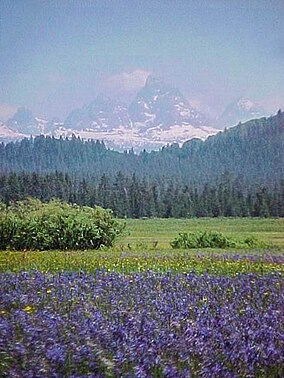Caribou-Targhee National Forest
| Caribou-Targhee National Forest | |
|---|---|
|
IUCN category VI (protected area with sustainable use of natural resources)
|
|

Camas flowers and the west vista of the Teton Range from Caribou-Targhee National Forest
|
|
| Location | Idaho-Wyoming-Utah, United States |
| Nearest city | Pocatello, ID |
| Coordinates | 42°47′0″N 111°33′0″W / 42.78333°N 111.55000°WCoordinates: 42°47′0″N 111°33′0″W / 42.78333°N 111.55000°W |
| Area | 2,630,716 acres (10,646.13 km2) |
| Established | 1903 |
| Governing body | U.S. Forest Service |
| Website | Caribou-Targhee National Forest |
Caribou-Targhee National Forest is located in the states of Idaho and Wyoming, with a small section in Utah in the United States. The forest is broken into several separate sections and extends over 2.63 million acres (10,600 km2). To the east the forest borders Yellowstone National Park, Grand Teton National Park and Bridger-Teton National Forest. Most of the forest is a part of the 20-million-acre (81,000 km2) Greater Yellowstone Ecosystem.
Caribou and Targhee National Forests were combined from original forest lands created in 1891. Two designated wilderness areas are located in the easternmost sections of the forest, bordering on National Park lands. The 123,451-acre (500 km2) Jedediah Smith Wilderness is adjacent to Grand Teton National Park on the western slope of the Teton Range. Known for karst limestone formations, the wilderness has many caves and provides excellent views of the less often seen west face of the Teton peaks. The smaller 10,715-acre (43 km2) Winegar Hole Wilderness borders Yellowstone National Park and the John D. Rockefeller, Jr. Memorial Parkway, and was set aside primarily to protect prime grizzly bear habitat.
While western sections of the forest have a mixture of sagebrush and grasses, the higher elevations in the east support lodgepole pine, and numerous species of spruce and fir. In addition to grizzlies most of the major megafauna associated with Yellowstone National Park can be found in Caribou-Targhee National Forest. Mammalian species of black bear, wolf, elk, moose, mule deer, bison, cougar, and pronghorn have all been seen by visitors on forest lands. An active peregrine falcon recovery program was begun to return this bird species to some of their ancestral range. Cutthroat trout, brook trout and pike are found in the streams and lakes and the forest is considered one of the best fishing areas in the world for cutthroat trout.
...
Wikipedia

